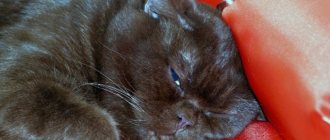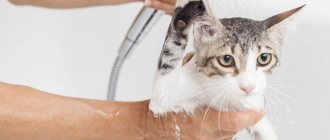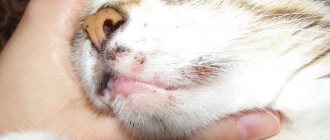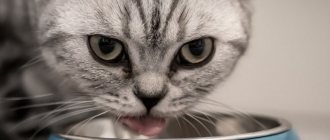Hormonal imbalance in cats is observed quite often. Problems occur due to disruption of the endocrine system. In this case, there is a deterioration in the condition of the coat and changes in the behavior of the animal. Veterinarians remind that hormonal imbalances can provoke a number of serious diseases, so it is important to eliminate the problem as quickly as possible.
Symptoms of hormonal imbalance in a cat
There are a number of signs that should make a cat owner suspect that his pet has a hormonal imbalance. First of all, this is a sharp increase in the amount of water you drink, and, accordingly, increased urination. The most alarming symptoms that may indicate certain endocrine disorders in the animal’s body are obesity or, conversely, sudden weight loss. Often, a cat’s hair begins to fall out, even to the point of complete baldness in some areas of the body – so-called alopecia areata. The most severe consequences of hormonal imbalance in a cat are tumors, both benign and malignant.
Causes
Reminent ovarian syndrome is the presence of female reproductive gland tissue in the body after attempted surgical removal. The remains of the ovary begin to function and cause sexual desire.
The age of the cat at the time of the operation does not matter, and the problem itself after an unsuccessful intervention may not appear immediately - after a month, or maybe after several years.
- Partial excision of the gonads.
- The presence of ovarian tissue on the ligament with unnatural anatomy (ectopia).
- Contamination of the abdominal cavity with ovarian tissues and their engraftment in a new place.
The remaining cells in the body can multiply and actively secrete hormones. Sometimes oncology occurs - neoplasia of a fragment of the ovary or mammary glands.
Causes of endocrine abnormalities in cats
Diabetes mellitus can be caused by prolonged overfeeding of an animal. Problem No. 1, which leads to deviations in the functioning of the endocrine system of the animal’s body, has been and remains the hormonal drugs that many owners give to their cats during the period of sexual heat. Such drugs cause great harm to the animal and can even lead to cancer. If you do not plan to breed cats, and your pet is not a purebred breeding animal, it is much more humane to sterilize it rather than stuff it with pills and drops.
Reminent ovarian syndrome in cats: symptoms, treatment
Sterilization of cats at a young age is gradually becoming a routine practice in Russia. A simple operation not only prevents sexual estrus, but also significantly extends the life of the animal. There are two possible surgical options: oophorectomy (only the ovaries are removed) and ovariohysterectomy (removal of the ovaries and uterus). In both cases, the pet stops estrus.
But there are times when a neutered cat again starts rolling on the floor, howling, and even lets the cats approach - sexual heat in our furry pets cannot be confused with anything! The owner is horrified - after all, he has already solved the problem radically, in the most reliable way. Sometimes the doctor who operated on a spree kitty vaguely makes the excuse that the adrenal glands supposedly took over the role of the ovaries and produce sex hormones. A qualified specialist will suspect ovarioreminant syndrome in such an animal.
How to treat hormonal imbalance in a cat
If the veterinarian has concluded that the cat lacks some natural hormone - a diagnosis of hypothyroidism has been made - then competent replacement therapy will guarantee a long life for your pet.
Most often, the cat is prescribed lifelong use of hormonal medications, on which its well-being depends. Otherwise, the animal can be called almost completely healthy. If a cat has insulin-dependent diabetes, she is prescribed daily insulin injections in a dosage selected by the veterinarian. If the disease has progressed and the cat has developed tumors - most often they occur on the mammary glands and ovaries - surgical treatment is indicated. Simultaneously with the operation to remove tumors, the animal is sterilized. In most cases, relapse of the endocrinological disease does not occur.
If an animal with some pathology in the endocrine system receives the correct doses of the necessary drugs in a timely manner and is under the supervision of a competent specialist, then it is highly likely to live a long and happy life.
Endocrine diseases in cats are relatively rare. However, there are several most common ones:
Diabetes
Hyperthyroidism
Obesity
Itsenko-Cushing syndrome
Hypothyroidism
Diabetes
It is characterized by a violation of carbohydrate metabolism caused by insufficient production of the pancreatic hormone - insulin.
Diabetes
is the most common endocrine disease in cats. The saddest thing is that by the time obvious symptoms appear, the disease has often progressed, sometimes to such an extent that all insulin reserves in the body have already been depleted.
What happens with diabetes?
The formation of carbohydrates is enhanced, and their absorption by the body's cells is impaired, which leads to an increase in sugar levels in the blood and tissues, and this, in turn, causes the destruction of pancreatic cells and a decrease in insulin production. Thus, a vicious circle is created that aggravates the course of the disease. All these changes lead to increased breakdown of proteins and a decrease in their synthesis. Not only carbohydrate and protein metabolism is gradually disrupted, but also fat, water and mineral metabolism.
The reasons that can give impetus to the development of the disease are the following: metabolic disorders, any infectious processes, trauma to the pancreas or its changes - inflammation, atrophy (reduction in size and dysfunction), sclerosis (replacement of the glandular tissue with connective tissue), hereditary predisposition.
Symptoms.
As a rule, the first signs of the disease appear a month and a half before the obvious clinical manifestations of diabetes mellitus - the cat drinks a lot of fluid, urination becomes more frequent, and the amount of daily urine increases. It is characteristic that urine does not have its own specific odor; it becomes lighter in color. As the disease progresses, the animal’s well-being deteriorates sharply: the cat refuses to eat, the general condition is depressed, and asthenia develops. Sometimes vomiting occurs once, but it may become more frequent if you continue to try to feed the animal. At this stage of the disease, the smell of acetone appears from the mouth.
Treatment.
Drugs that lower blood sugar are prescribed:
short-, medium- and long-acting insulin is available;
drugs for oral administration;
The choice of drug, its dosage, method and frequency of administration depends on the general condition of the animal and blood sugar levels.
Hyperthyroidism
Characterized by increased thyroid function. It is the second most common endocrine system disorder in cats.
Cats of all breeds, both females and males, and at any age can develop hyperthyroidism. However, animals that are on average older than 9-10 years are most susceptible to this disease. It has been observed that Siamese and Himalayan cat breeds are less prone to hyperthyroidism.
What happens with hyperthyroidism?
The main function of thyroid hormones is to regulate metabolism (the speed of cell work) in the body, and their excessive production leads to the fact that all processes in organs and tissues occur faster.
Causes.
The most common is adenoma (benign tumor of the thyroid gland). Somewhat less frequently, the cause that triggers the development of hyperthyroidism can be adenocarcinoma (a malignant tumor). An important role in the development of the disease is played by the increased iodine content in feed, a certain habitat, and the harmful effects of insecticides, herbicides, and fertilizers.
Symptoms.
The animal loses weight despite eating well. The cat may lose some of its hair, it drinks a lot, and tends to stay in cool places. The animal is overly active, but at the same time gets tired quickly. There is an increase in the amount of daily urine, and sometimes diarrhea and/or vomiting appears.
Treatment is carried out in three directions:
surgical removal of the thyroid gland;
prescribing medications that block excess production of thyroxine (thyroid hormone);
treatment with radioactive iodine - a drug is administered that accumulates in the thyroid gland and destroys tissue with increased function;
Obesity
It is quite widespread among cats, affecting about 40% of pets. The disease is characterized by excess fat deposition. Cats of the Persian and British breeds are most prone to obesity.
The causes of obesity are numerous.
First of all, they lie in the animal’s poor nutrition, passion for treats and a sedentary lifestyle. In second place are any endocrine disorders (hypothyroidism, changes in hormonal levels after castration or sterilization), chronic diseases (arthritis), and taking certain medications (glucocorticoids). In addition, there are predisposing factors - old age, stressful situations, heredity.
Symptoms
generally depend on the degree of obesity. However, most often the disease manifests itself as follows:
the animal’s belly sag, a characteristic “waddle” gait appears, pronounced fat deposits are visible on the hips;
the cat is apathetic and sleepy, she has difficulty jumping;
Treatment
includes eliminating the cause that led to the development of obesity, prescribing a balanced diet (reducing portion size and amount of carbohydrates, eliminating fats) and increasing energy consumption by increasing physical activity.
Itsenko-Cushing syndrome
Characterized by increased function of the adrenal cortex. The prevalence in cats is low.
The disease occurs in the form of two syndromes - primary (the pathological process develops in the adrenal cortex) and secondary (the function of the brain structures that control the functioning of the adrenal cortex is impaired). The last option is the most common.
Causes
, according to which Itsenko-Cushing syndrome can develop, are not so numerous; they include damage to the adrenal cortex and the hypothalamic-pituitary system (it controls the production of hormones by the adrenal cortex and is located in the brain). These can be tumors (adenoma), injuries. In addition, the impetus for the development of the disease can be given by taking certain medications, for example, glucocorticoids.
Symptoms
. There is a redistribution of fat - excessive deposition of adipose tissue in certain places (abdomen). The skin feels dry to the touch, can be easily injured, and has areas of hyperpigmentation. Muscle tone decreases, hair falls out. The animal has increased thirst and increased urination. The cat has a hard time with physical activity.
Treatment
carried out in two directions: 1) surgical removal of the tumor; 2) prescribing medications that suppress excessive adrenal function.
Hypothyroidism
A disease of the thyroid gland, characterized by a decrease in its function. It is extremely rare in cats. With hypothyroidism, all metabolic processes in the body slow down.
Causes.
The most common cause is removal of the thyroid gland or radiation therapy for hyperthyroidism. In addition, hypothyroidism can be caused by insufficient iodine intake from food. Sometimes the disease is congenital - there is underdevelopment of the thyroid gland, or congenital insufficient production of thyroxine
Symptoms
varied and appear gradually. A sick animal becomes lethargic, drowsy, and quickly gets tired. Due to the fact that metabolic processes are slowed down (heat transfer exceeds heat production), the cat’s body temperature decreases, and it constantly looks for warmer places. As the disease progresses, the animal's fur becomes dull and falls out over almost the entire surface of the skin (total alopecia). The skin becomes cold and firm to the touch, and appears swollen. The animal is gaining weight.
Treatment
consists of prescribing medications containing thyroid hormone.
The endocrine system is an important part of the cat's body. When it works correctly, the animal adapts to its external environment, it affects the processes of reproduction and the functioning of the body in a certain mode. Hormonal imbalance in cats leads to the development of many diseases.
The endocrine system of cats is complex and consists of the following components:
:
- pituitary;
- epithelial body;
- thyroid;
- ovaries in females and testes in males;
- adrenal glands;
- pancreas.
A cat, like a person, can have hormonal imbalances; no living creature is protected from this; a number of diseases can result from this. The reasons may be different, sometimes due to improper behavior of the owner. So, overfeeding or food that is not suitable for a cat can cause obesity and diabetes. Taking hormonal drugs is also at risk. Sometimes, against the background of previous diseases, such as mastitis (and it can occur in a cat, as well as in a woman after childbirth), diseases of the nervous system can also affect hormonal disruption of the endocrine system.
Results and discussion
As a result of the analysis of anamnestic data in four cats of the 3rd group (after ovariohysterectomy), manifestations of sexual heat were noted that occurred from one to several times a year, which became the basis for a separate consideration within this group of animals that underwent surgical intervention (n=30) , cats with signs of sexual heat (n=4). When studying the level of sex hormones (testosterone and progesterone) in 3 groups, the results presented in the table were obtained.
Determination of testosterone content showed that, despite the tendency to a slight increase in cats after ovariohysterectomy, in general the level of the hormone in all castrated animals was within the laboratory and species norm, which indicated the absence of pathological changes in the adrenal glands.
However, in the context of the topic under study, the most significant and revealing were the results obtained from the study of progesterone content. Thus, if in the main group of animals after ovariohysterectomy (n=26) an expectedly low level of this hormone was observed (on average 7 times lower than in the control), then in the group of castrated cats with restored signs of sexual estrus (n=4) and in for the control group it was essentially the same. These data, correlating with behavioral signs of heat, indicated the presence of residual ovarian tissue in the body and the possibility of developing OOC. To confirm the diagnosis of EOC, the level of AMH in the blood serum was additionally examined in all cats [4, 8, 10], the results of which are also shown in Table 1.
A comparative analysis of the results showed that in all castrated cats without signs of heat, the level of AMH was on average 40...50 times lower than in the control group and in the group of cats receiving GCP. Moreover, their hormone content was fully consistent with the literature data, which defines it as not exceeding 0.14 ng/ml [4, 8, 10]. In cats that underwent surgical intervention and over time restored signs of estrous behavior, the level of AMH was significantly higher than in other castrated animals and reached 1.56 ng/ml, which confirmed the preliminary diagnosis of EOC.
It should be noted that the proportion of cats diagnosed with EOC in our study was very significant and amounted to more than 13% in relation to the total number of operated animals. As practice shows, successful treatment can only be carried out surgically, but it is significantly complicated by the problem of establishing the localization of residual ovarian tissue. In addition, repeated surgery involves additional blood loss and contributes to the development of adhesions in the pelvis, which in turn leads to impaired mobility of intestinal loops and intestinal obstruction.
Table 1. Content of sex hormones in the blood of cats using various methods of contraception and control animals
source
Symptoms
It is important to notice in time that something is wrong with your pet and identify the symptoms of hormonal imbalance:
- the cat is constantly thirsty;
- change in body weight, its sharp decrease or increase;
- the cat constantly becomes sleepy, its activity is lost;
- impairment of vision and smell may occur;
- the coat often suffers, it becomes dull and hangs in clumps, and in some places complete baldness can occur;
- the consequence of a hormonal disorder can be the most terrible symptom - the formation of a tumor, both benign and malignant.
Traumatic hernias
Quite often, as a result of impacts in the abdominal wall, hernias are formed - the prolapse of internal organs (intestines, bladder) beyond the abdominal wall as a result of rupture of its muscles and tendons. At the same time, the integrity of the skin is preserved. Externally, this type of injury looks like a swelling, sometimes accompanied by a hematoma, in the area of the central abdominal wall and groin. Depending on the type of hernia, and it can be strangulated or not strangulated, reducible or irreducible, the general condition of the animal also changes. With a non-strangulated hernia, most often the animal does not experience severe pain or discomfort, and the area of prolapse does not show signs of inflammation. Urination and defecation also do not always undergo any changes. The danger of a non-strangulated hernia is that strangulation can occur at any moment, which is accompanied by severe pain, hyperemia, and dysfunction of the prolapsed organ. This type of injury requires immediate surgical intervention. In the presence of a non-strangulated hernia resulting from an injury to the abdominal wall, surgery is also indicated, but in this case we are talking about a planned intervention. During the operation, the doctor determines the presence or absence of damage to the prolapsed organ; if everything is in order with the organ, then it is returned to the abdominal cavity, and the defect is restored.
Treatment
It is important to diagnose the disease in time, only then can proper treatment be prescribed. Hormonal disorders need to be treated depending on their type and nature. For example, if it is a tumor, the doctor will suggest surgically removing it to save the cat. In some cases, radiotherapy is used, using radioactive iodine.
But most often, cats have to be treated through the use of medications and hormonal drugs, these can be thyroid hormones, steroids, and insulin. Even if the cat does not want to take the medicine, it must be forced to do so. You need to be prepared for the fact that the treatment will be lengthy due to some kind of hormonal imbalance in the body. Some animals need therapy for the rest of their lives. Periodically, the cat will need to be shown to a veterinarian to monitor the situation and adjust the prescription of medications.
How is the treatment carried out?
Obese animals need walks.
Svetlana Vladimirovna Vasilyeva, a teacher at the Department of Biochemistry of the Veterinary Academy, notes that the course of treatment for hormonal imbalance depends on what disease caused it. If obesity is the cause of the problem, the cat is prescribed a diet, as well as long walks in the fresh air. Eating food should be in small portions at least 5 times a day. When hormonal imbalance is caused by diabetes mellitus, a diet is also first prescribed, after which insulin is prescribed.
Diabetes insipidus cannot be cured, but subcutaneous administration of Pituitrin will help alleviate the symptoms. If hypoadrenocorticism is detected, the animal requires urgent help and instillation of a solution of sodium salt with glucose. For Itsenko-Cushing's disease, treatment involves the use of hormonal medications that help normalize the functioning of the pituitary gland. Sometimes surgery is required to remove the adrenal glands. Hyperthyroidism is treated with thyroid hormones. As for hyperthyroidism, treatment involves the use of radioactive iodine or surgery.
Diabetes
Perhaps this disease can be called the most common among endocrine diseases in animals. What causes hormonal imbalance? The cat's body stops producing glucose and continues to exist without it. The consequence is an increase in sugar, which can be diagnosed by passing urine for testing. Pathology occurs in the improper functioning of the pancreas
, while the production of the main hormone insulin occurs in insufficient quantities for the normal functioning of the cat’s body.
In severe cases, the production of this hormone completely stops. With a constant feeling of hunger, the cat begins to lose weight. When prescribing treatment, a corrective diet is required. Sugar and bread are excluded, vitamins are prescribed, and the water will need to be alkalized using regular soda. It is better to boil meat and vegetables. Before feeding, the cat is prescribed insulin in certain doses.
Compared to humans, it is quite primitive. In fact, a cat also has a complex endocrine system, and sometimes these cute animals can have hormonal imbalances. How to identify them, why are they dangerous, and most importantly, how to treat a cat whose hormones have “revolted”?
Unfortunately, just like people, cats have problems with the endocrine system. They need to be identified in a timely manner, diagnosed and given the correct treatment, otherwise the animal’s quality of life will deteriorate significantly. By what signs can you determine that your pet has a hormonal imbalance?
Causes of the problem and accompanying symptoms
Obesity and hormonal imbalance
Excessive body weight is observed due to improper diet, when owners feed the animal excessively fatty foods or products that contain too many carbohydrates. Pets who lead a sedentary lifestyle are more susceptible to obesity. Hormonal imbalance can occur due to obesity and also due to thyroid deficiency. The following signs are identified:
- the presence of folds on the skin;
- change in behavior, lethargy;
- heavy breathing even with minimal physical activity;
- diarrhea.
Diabetes
It is an endocrine disease characterized by impaired glucose absorption. The main cause of this disease is a disruption of the pancreas. The following symptoms of pathology are distinguished:
With this disease, the animal tends to eat a lot.
- increased appetite;
- thirst;
- frequent bowel movements;
- light yellow shade of urine;
- weight loss;
- dyspnea;
- catarrhal pneumonia;
- diarrhea followed by constipation.
Diabetes insipidus
Despite the similar name of the pathology, the disease is not associated with the absorption of glucose. The disease is characterized by a malfunction in the water-salt balance. The exact reasons that provoke the development of the disease have not been established. However, most veterinarians agree that diabetes insipidus can be caused by injuries to the skull, as well as diseases of the central nervous system. Characteristic symptoms:
- constant thirst;
- frequent urge to urinate;
- decreased appetite;
- lack of salt and sugar in the urine;
- reducing the weight of the animal;
- sedentary lifestyle.
Hypoadrenocorticism
Insufficiency of the adrenal cortex contributes to severe weight loss in the animal.
It is an insufficiency of the adrenal cortex, resulting in a lack of aldosterone and insufficient sodium retention. The following signs are inherent in pathology:
- complete loss of appetite;
- apathy;
- dehydration of the body;
- severe weight loss;
- attacks of nausea;
- diarrhea;
- renal failure in the acute stage.
Itsenko-Cushing's disease
Characterized by increased production of adrenal hormones. As this disease progresses, the pet's skin becomes more sensitive, and bruises occur from any blows. The coat becomes disheveled and may fall out. One of the main symptoms that is characteristic of this disease is muscle tissue dystrophy. As a result, the animal becomes lethargic. If you take a blood test, the results show a noticeable increase in cholesterol and sugar levels. The animal is bothered by strong thirst and a constant desire to defecate.
Acromegaly
With this pathology, the animal's limbs become enlarged.
It is a dysfunction of the anterior pituitary gland. Mostly pathology occurs due to the development of neoplasms. The disease is often diagnosed in older cats. This disease causes diabetes mellitus, so the symptoms are very similar. The pet begins to feel very thirsty, constantly goes to the toilet, and its appetite increases. In addition, there are additional signs that manifest themselves in the form of enlargement of the limbs, as well as internal organs.
Hypothyroidism
Characterized by a long-term lack of thyroid hormones. Symptoms:
- weakness;
- hair loss;
- decrease in body temperature;
- slow heartbeat;
- constipation.
Hyperthyroidism
An animal with hyperfunction of the thyroid gland breathes very quickly.
Increased production and inadequately high release of thyroid hormones into the blood. It is often diagnosed in older cats. The symptoms are:
- frequent bowel movements;
- high appetite;
- gagging and diarrhea;
- severe weight loss;
- frequent breathing.
Symptoms of hormonal imbalance in a cat
There are a number of signs that should make a cat owner suspect that his pet has a hormonal imbalance. First of all, this is a sharp increase in the amount of water you drink, and, accordingly, increased urination. The most alarming symptoms that may indicate certain endocrine disorders in the animal’s body are obesity or, conversely, sudden weight loss. Often, a cat’s hair begins to fall out, even to the point of complete baldness in some areas of the body – so-called alopecia areata. The most severe consequences of hormonal imbalance in a cat are tumors, both benign and malignant.
Diabetes insipidus
Despite the similar name, the disease has nothing to do with glucose absorption. With this pathology, water-salt metabolism in the animal’s body is disrupted.
The exact etiology has not been established, but the disease is often observed after traumatic brain injury, as well as diseases affecting the central nervous system (encephalitis, meningitis, plague). Pathology occurs when the diencephalic-pituitary system is disrupted.
Symptoms
The cat has a strong, unquenchable thirst and increased urination. Appetite is often normal or absent. The urine is light, transparent, there is no sugar or salt in the urine. The cat loses weight, moves little, and develops heart failure. Blood sugar is normal, there is no sugar in the urine, and there is no urea.
Treatment
The prognosis for the disease is unfavorable; symptoms may subside, but the animal cannot be cured. Temporary and mild relief is provided by the subcutaneous injection of 0.03-0.1 ml of pituitrin. The water is slightly acidified with acetic acid. In the diet, reduce the amount of animal proteins and salt, increase the amount of plant foods.
Causes of endocrine abnormalities in cats
Diabetes mellitus can be caused by prolonged overfeeding of an animal.
Problem No. 1, which leads to deviations in the functioning of the endocrine system of the animal’s body, has been and remains the hormonal drugs that many owners give to their cats during the period of sexual heat. Such drugs cause great harm to the animal and can even lead to cancer. If you do not plan to breed cats, and your pet is not a purebred breeding animal, it is much more humane to sterilize it rather than stuff it with pills and drops. If the veterinarian has concluded that the cat lacks some natural hormone - a diagnosis of hypothyroidism has been made - then competent replacement therapy will guarantee a long life for your pet. Most often, the cat is prescribed lifelong use of hormonal medications, on which its well-being depends. Otherwise, the animal can be called almost completely healthy. If a cat has insulin-dependent diabetes, she is prescribed daily insulin injections in a dosage selected by the veterinarian. If the disease has progressed and the cat has developed tumors - most often they occur on the mammary glands and ovaries - surgical treatment is indicated. Simultaneously with the operation to remove tumors, the animal is sterilized. In most cases, relapse of the endocrinological disease does not occur.
If an animal with some pathology in the endocrine system receives the correct doses of the necessary drugs in a timely manner and is under the supervision of a competent specialist, then it is highly likely to live a long and happy life.
Attention, TODAY only!
Everything interesting
Many responsible owners sterilize cats not intended for breeding. It is not uncommon to hear that a spayed female still asks for a male cat. Can such stories really have any basis, and for what reasons...
Unfortunately, not all cat owners are of the opinion that the reproduction of these animals needs to be controlled. It is especially sad when the cat is free-range and mats uncontrollably, producing 3-4 litters of kittens per year. Outbred...
Not everyone knows that a condition such as depression affects not only people, but also animals. Cats in particular are susceptible to depression. The cat is a domesticated animal. Despite this, it is not easy for her to exist in captivity, because...
The cute little cat very soon becomes an adult, ready to breed. And during the period when the cat is ready to communicate with the cat, it causes a lot of trouble to its owners. To avoid these unpleasant moments, it is advisable for owners...
Cat owners sometimes encounter the phenomenon of coughing in their pets. Coughing in cats occurs quite rarely, and in some cases it may indicate the presence of very serious diseases in the animal. Instruction 1It’s normal to have a cough...
The constant and sometimes uncontrolled reproduction of domestic cats often creates many problems for their owners. Hence the stray cats, which complicate the epidemiological situation in different cities. One of the most successful and modern ways…
Some time ago, a disease such as piroplasmosis, which is transmitted by ixodid ticks, was dangerous only for dogs. However, not so long ago, a pathogen became no less widespread and dangerous exclusively for predators of the cat family...
Just like humans, cats can develop a reproductive system infection or even a sexually transmitted disease. It is important to make a correct diagnosis in a short time and begin treatment of the animal before the disease becomes chronic. Only in…
If a cat is terminally ill and treatment does not bring results, then a veterinarian can alleviate the animal’s suffering in a humane way. This method is called euthanasia. The medical term is euthanasia. Indications for euthanizing a cat may be...
The reproductive instinct is strong in domestic animals, as well as in those who live in natural conditions, and animals, unlike humans, cannot control it. Therefore, if you are not going to engage in breeding, when purchasing a cat for your home, immediately...
Hormonal imbalance is a disorder in the endocrine system in both women and men. The endocrine system has a great influence on the functioning of important organs, especially on the functioning of the central nervous system, which is responsible for…
It is known that owners of “yard” cats often resort to sterilization of their pets, since problems often arise with the sale of outbred kittens. It's a different matter when the cat is purebred. Any diseases of the reproductive system in this case are fraught with serious financial losses. Endometriosis in cats is especially dangerous in this regard, in many cases fraught with the complete loss of the animal’s ability to give birth to kittens.
In general, cats do not have such a disease. Paradox? No, there is simply confusion in this case with medical and veterinary terms. In human medicine, “endometriosis” is a severe pathology in which epithelial cells of the uterus “take root” on the walls of the fallopian tubes, in the ureters and bladder, as well as on the surface of the external genitalia. All this leads to severe hormonal imbalances and dramatically increases the likelihood of developing gynecological infections.
It is possible that it was for this reason that feline pyometra suddenly became “endometriosis,” although these pathologies have little in common. The main reason why some veterinarians group these diseases together is a serious hormonal imbalance in the sick animal. Let us repeat once again that cases of “canonical” endometriosis among cats have never been identified to this day, and therefore the use of this term is largely erroneous.
Symptoms and diagnosis
A preliminary diagnosis is made based on external manifestations - signs of estrus in a castrated cat:
- behavioral changes: heart-rending meowing, increased excitability;
- frequent urination, sometimes marking territory;
- decreased appetite, anxiety.
If signs of a false pregnancy appear (mammary hyperplasia, lactation), there is no doubt that the ovaries are there and they are functioning. If the problem is running, you may experience:
- permanent vaginitis;
- purulent discharge from the loop;
- general exhaustion.
If the medical history is unknown (a stray animal), the doctor examines the abdominal wall for the presence of a scar after sterilization and refers it to an ultrasound scan. If sterilization was knowingly carried out, ultrasound can only be an auxiliary diagnostic method. In this case, to exclude an error, laboratory tests are performed before laparotomy:
Cytological examination confirms estrus by keratinized epithelial cells in the absence of erythrocytes and leukocytes.
- Estradiol level determination.
Although a reduced level of estrogen in the blood does not exclude the diagnosis, an increase in the concentration of estradiol above a certain level clearly indicates ovarioreminant syndrome, so the analysis can be informative.
During sexual heat, an injection of human chorionic gonadotropin (Chorulon, Intervet or Cystorelin, Merial) is given intramuscularly 500 units. After 1-2 weeks, progesterone levels are determined. The injection provokes ovulation of mature follicles, if they are present in the body. Progesterone above 3 nmol/l indicates the existence of ovarian tissue.
If there are no signs of estrus, gonadotropin-releasing hormone (Receptal, Intervet) is used. A blood test is taken from the cat, Receptal (buserelin) is administered subcutaneously or intramuscularly at 0.4 mcg/kg, then after 3 hours a blood sample is taken again. The content of estradiol is determined before and after the stimulating injection. A level of 10 nmol/l and higher in the second sample proves remineral syndrome.
- Determination of Anti-Mullerian hormone.
This is a biologically active substance that is produced by special cells of the gonads (ovaries or testes). AMH levels are routinely tested abroad. In Russia, it is determined in humane medicine, but such a test is not yet available in most veterinary laboratories.
Predisposing factors
So what is it? This is the name for the accumulation of pus and decay products in the uterine cavity. What are the reasons for such an unpleasant pathology? They are quite complex. Under normal conditions, the uterine cavity is absolutely sterile and impermeable even to lymphocytes. When a cat is in heat, the cervix opens slightly, the same thing happens during childbirth, which is logical. But if some kind of “error” has crept into this physiological process (for example, a persistent corpus luteum remains in the ovaries), the cervix remains open, and pathogenic and conditionally pathogenic microflora can enter the organ cavity.
What makes the situation worse is the fact that, under the influence of hormones, the endothelial lining of the uterus undergoes hyperplasia (that is, grows) and begins to secrete a large volume of liquid secretion, which becomes an ideal environment for the development of bacteria. In addition, the progesterone released during this process blocks the contractility of the muscular lining of the organ, as a result of which the contents accumulated in the uterus cannot be evacuated naturally.
can occur in any cat
, whose ovaries have not been removed, but the vast majority of cases relate to animals older than five years of age. This pathology is almost guaranteed to develop if, due to some hormonal imbalance, it lasts more than 30-45 days. So if you notice an inappropriately long period of heat in your pet, take her to the vet immediately.
Development of diseases of the endocrine system in cats
The cat's body monitors and regulates hormone levels using a feedback system specific to each hormone. The functions of hormones are to keep factors such as temperature and blood sugar levels within certain ranges. In some cases, to keep body functions in balance, hormones with opposite functions work in pairs.
Endocrine system diseases can develop when the body produces too many or too few hormones, or when the normal way hormones are used or removed is disrupted. Symptoms of the disease occur in the organs that produce hormones or due to problems in other parts of the body that affect the secretion or action of a particular hormone.
Tumors or other abnormalities in the endocrine glands often lead to increased production of the corresponding hormones.
The pituitary gland produces various important hormones that control many organs and some endocrine glands. Because of the role the pituitary gland plays, it is called the master gland. Various diseases can cause problems with the pituitary gland. Symptoms of a particular disease depend on the cause and the part of the pituitary gland that is affected by the disease.
A pituitary tumor can cause pituitary hyperadrenocorticism (Cushing's syndrome), panhypopituitarism, and acromegaly.
The antidiuretic hormone of the pituitary gland (vasopressin), which is responsible for maintaining the correct level of fluid in the body, if the normal functioning of the pituitary gland is disrupted, causes diabetes insipidus in cats.
Disorders of the endocrine glands manifest themselves in two main forms: hyperfunction (excessive function) and hypofunction (insufficient function).
Hyperthyroidism can be caused by a pathology of the thyroid gland itself (tumor); otherwise, the cause should be sought in disturbances in the functioning of the pituitary gland, which plays a special role in maintaining hormonal levels and regulates the functioning of other endocrine glands.
In many cases, disorders in the gland not only lead to overproduction of hormones, but it usually does not respond to feedback signals. This can cause hormones to be released in situations that would normally require their production to be reduced.
Receiving signals about an excess or deficiency of hormones from a particular gland, the pituitary gland inhibits the production of its own hormones. This mechanism of action of the pituitary gland and peripheral glands is very reliable, but the occurrence of an imbalance in this complex circuitry can lead to a chronic disease such as hypothyroidism.
Abdominal injuries
Bladder rupture
This type of injury occurs in animals as a result of a strong blow. Kittens have a very thin, imperfect abdominal wall and a fairly small layer of subcutaneous fat that could prevent injury to the abdominal organs, which is why even a relatively weak blow can lead to a rupture of the bladder. Symptoms of such damage are the depressed state of the animal, decreased or complete absence of appetite, increased general body temperature, pain in the abdominal cavity, complete or partial absence of urination, or hematuria. To make a diagnosis, it is necessary to conduct special studies - ultrasound of the abdominal organs, x-ray examination, retrograde urethrocystography and excretory urography. If a bladder rupture is confirmed, the cat is scheduled for surgery to repair the rupture. During the operation, the surgeon inspects the internal organs to determine associated damage and, if any, eliminates them. After surgery, the animal needs subsequent rehabilitation therapy and requires special postoperative care.
Spleen, liver and kidneys
Falls from a height or strong impacts in cats can lead to damage to one or more abdominal organs, among which one of the most dangerous is a ruptured spleen. Its danger lies in the fact that the organ is highly vascularized, which means that if damaged, there is a high risk of severe bleeding. The main signs of this type of injury are general weakness of the animal, a spongy state, pain in the abdomen, sometimes an increase in its volume (this occurs due to massive bleeding and accumulation of blood in the abdominal cavity), the abdomen is tense, the mucous membranes of the animal (conjunctiva, oral mucosa) ) pale, even marble-colored. This condition can occur quite quickly, within 2-4 hours after the injury, and the longer the animal is left without veterinary care, the less chance of its salvation. If a rupture of the spleen is suspected, a number of studies are carried out: a general blood test, ultrasound, x-ray of the abdominal cavity; often a diagnostic laparotomy may be necessary, during which the surgeon will inspect all organs of the abdominal cavity and eliminate the detected lesions. In the case of the spleen, quite often when it ruptures, a splenectomy is required, that is, removal of the damaged organ. In the future, its absence will not greatly affect the animal’s quality of life.
Unlike the spleen, the liver and kidneys rarely cause severe bleeding when damaged, but control over the animal’s condition is necessary. For liver injuries, surgery is often used as a treatment, as a result of which only the damaged vessels are ligated, and the organ itself is not touched; in especially severe cases, it becomes necessary to remove a certain lobe or lobes of the liver, which also does not affect the cat’s life expectancy in the future.
As first aid, which can be provided to a pet immediately after an injury and before visiting a veterinary clinic, it is possible to apply a tight bandage to the abdomen. This will prevent severe blood loss and will temporarily stabilize the animal’s condition. However, such a bandage must be applied for a minimum period of time, otherwise the blood supply to all abdominal organs will be disrupted due to pressure, which will negatively affect the pet’s condition.











